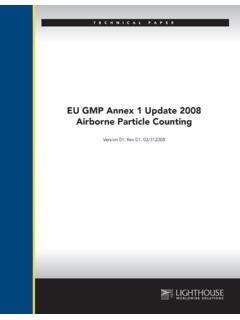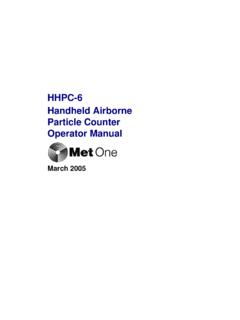Transcription of What Do Particle Counters Mean?
1 T E C H N I C A L P A P E R. what Do Particle Counters Mean? Version 01. Rev 01. September 2005. Info Overload: what Do My Particle Counts Mean? know, other than the Environmental Protection Agency's and PM10 (mass concentration), there are no standards for particulate levels in the IAQ industry. This is due in part to the nature of airborne particulates, and the many influences that man and nature play in particulate generation and movement. Particle counter Terminology There are different types of Particle Counters . handheld, portable and remote. For ease of portability, I. generally use a handheld instrument during IAQ. investigations. When using Particle Counters , one needs to be aware of certain terms or phrases that are commonly used when describing functions of the instrument, or how the data is viewed and reported.
2 Data are displayed in either Cumulative or Differential mode. When viewing the data in Cumulative mode, the number (counts) associated with each channel size is the number of particles that the instrument counted for that size and greater. Jim Akey Inside Sales Eastern Lighthouse Worldwide Solutions Medford, Ore. what is the difference between an orange? You may be thinking, what kind of question is that? Different than what ? Common sense, and a decent background in the English language, tells us we need to compare the orange to something else to determine any differences. One of the most common questions I am asked regarding Particle Counters pertains to the values, or Particle counts, the instrument just recorded.
3 I am often asked, Jim, I just took a sample with my new Particle counter . I got Figure 1. 40,000 counts at (microns). what does this mean? Is that good or bad? Figure 1 shows that 5,380 particles were in My typical response to this question is that one set of diameter and greater; 3,260 particles that were in data, in and of itself, means very little. Kind of like the diameter and greater; 2,572 particles that were in question I posed earlier regarding the orange. Unless we diameter and greater; and so on. compare the Particle counts to a baseline of previously If the data are being viewed in Differential mode, then recorded counts, the new set of data has little value.
4 As we the counts associated with each channel size would indicate the number of particles that are at least that micron size in This article is reprinted from Volume 6, Issue 11 (September 2005). of Indoor Environment Connections newspaper. For subscription information, visit Table 1. diameter, up to, but not including the next size. Using the Most Particle Counters allow you to select a sample data above (if sampled in Differential mode), we would see time or volume for each sample. Handheld Particle Counters that there are 5,380 particles that are between and are generally set to sample CFM. I would suggest that ; 3,260 particles that are between and ; you sample for at least one minute; this ensures that you 2,572 particles that are between and , etc.
5 Test enough air to give a representative idea of what is Data format is also an important idea to understand. happening in the area being sampled. Often, I will take Some handheld Particle Counters display the data as either three samples at each location and use the average of the raw (actual number of particles counted for the time or three counts. volume being sampled) or normalized (generally used when Many Particle Counters allow you to assign location certifying or verifying cleanroom classifications). numbers to your samples. Changing location numbers when Regardless of the sample time or volume, the count results you sample in different areas assists in keeping the data in a are displayed in particles per cubic foot or cubic meter.
6 If a logical order. Each time you move the Particle counter , one-minute sample is taken ( cubic feet per minute), the change the location number. This, combined with a counts are multiplied by 10 to give the results in particles timestamp including the date, will ensure that your data are per cubic foot; this is done to meet the cleanroom standards represented clearly and concisely. requirement of particles per cubic foot (Federal Standard Table 1 shows a sample download of some counts 209e) or particles per cubic meter (ISO 14644-1). (These taken in seven different locations around our office. Data standards are explained in further detail later in this article.)
7 Were gathered in Cumulative mode, and the counts are in This article is reprinted from Volume 6, Issue 11 (September 2005). of Indoor Environment Connections newspaper. For subscription information, visit raw format. Figures for temperature and relative humidity Comparing Particle Counts to Cleanroom are also included. Three samples were taken at each location, and an average was provided for each set of data. Standards There are a number of industries outside the IAQ. Also, note that the counts taken outside are higher than any profession that require manufacturing to be done in a clean, of the samples taken indoors. controlled environment commonly called cleanrooms.
8 The counts in Location 7 are extremely low. This area These are specially designed areas where temperature, is a laminar flow hood, and is where sensors for our Particle humidity, airborne particulates, differential pressure, Counters are manufactured. Also, notice the counts that are electrostatic discharge, airborne molecular contamination, in diameter and greater. Outside, there were an and other factors are all closely monitored and controlled. It average of 2, counts at and greater (which has been proven that excess particulate matter will have a equates to 22,893 counts per cubic foot). If any of the other negative effect on product yield for manufacturers of six locations were to have that many counts, I would have semiconductors and disk drives.
9 For the pharmaceutical, been concerned, as this indicates the possibility of active biotechnology, and medical device-manufacturing mold growth. As you can see, none of the other locations industries, the Food and Drug Administration requires that were within even 50 percent of this the closest being the all devices and drugs be produced in a controlled men's room at 32 percent! environment. As alluded to earlier, the two cleanroom standards Particle Counters Used in an IAQ Investigation currently being used in the United States are the Federal Now that we are familiar with Particle counter Standard 209e and ISO 14644-1. Standard 209e is being terminology, let's focus on how a Particle counter can assist replaced by the newer ISO 14644-1 standard, but about 60.
10 Us with our IAQ investigations. As we know, Particle percent of our customers are still using it. Counters offer immediate results that define the number of In both standards, there are different classifications of particles present in the sample volume, as well as a size cleanrooms denoting the cleanliness level. For Standard distribution. Each individual IAQ professional can 209e, the classifications are Class 1 (the cleanest . determine his or her own sampling methodology, but each designation), Class 10, Class 100, Class 1,000, Class 10,000. plan should contain a few basics. and Class 100,000. For the ISO 14644-1, the classifications First and foremost, when sampling in either a are ISO 1 (cleanest), ISO 2, ISO 3, ISO 4, ISO 5, ISO 6, residential or business setting, Particle counts should be ISO 7, ISO 8 and ISO 9.









